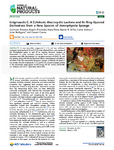Enigmazole C: A Cytotoxic Macrocyclic Lactone and Its Ring-Opened Derivatives from a New Species of Homophymia Sponge

Ver/
Use este enlace para citar
http://hdl.handle.net/2183/31043
A non ser que se indique outra cousa, a licenza do ítem descríbese como Atribución 4.0 Internacional
Coleccións
- Investigación (FCIE) [1228]
Metadatos
Mostrar o rexistro completo do ítemTítulo
Enigmazole C: A Cytotoxic Macrocyclic Lactone and Its Ring-Opened Derivatives from a New Species of Homophymia SpongeAutor(es)
Data
2022-03-02Cita bibliográfica
Tarazona, G.; Fernández, R.; Pérez, M.; Millán, R. E.; Jiménez, C.; Rodríguez, J.; Cuevas, C. Enigmazole C: A Cytotoxic Macrocyclic Lactone and Its Ring-Opened Derivatives from a New Species of Homophymia Sponge. J. Nat. Prod. 2022, 85 (4), 1059–1066. https://doi.org/10.1021/acs.jnatprod.1c01179
Resumo
[Abstract] A new macrolide, enigmazole C (1), and two additional analogues, enigmazoles E (2) and D (3), were obtained from a new species of the Homophymia genus as part of an ongoing discovery program at PharmaMar to study cytotoxic substances from marine sources. The structures were fully characterized by cumulative analyses of NMR, IR, and MS spectra, along with density functional theory computational calculations. All three of the new compounds feature an unusual 2,3-dihydro-4H-pyran-4-one moiety, but only enigmazoles C (1) and D (3) showed cytotoxic activity in the micromolar range against A-549 (lung), HT-29 (colon), MDA-MB-231 (breast), and PSN-1 (pancreas) tumor cells.
Versión do editor
Dereitos
Atribución 4.0 Internacional
ISSN
0163-3864
1520-6025
1520-6025






